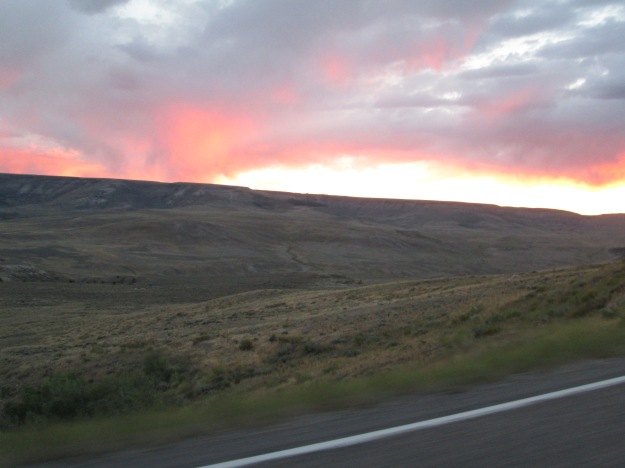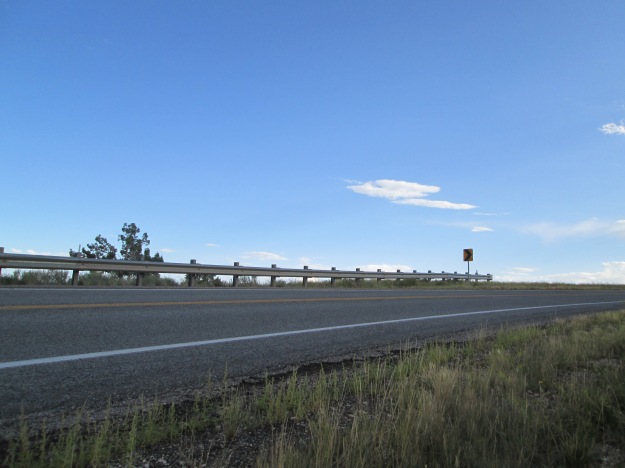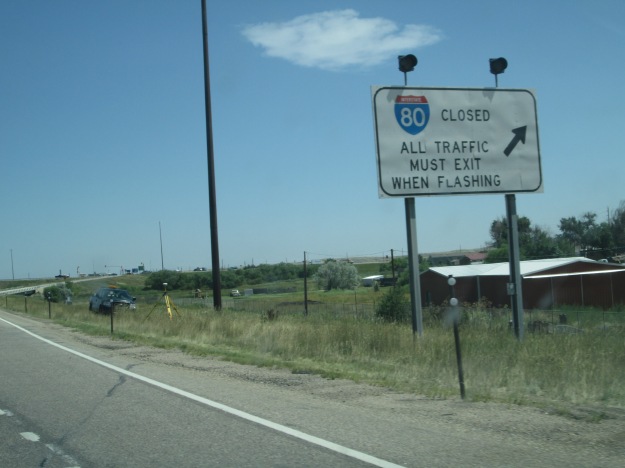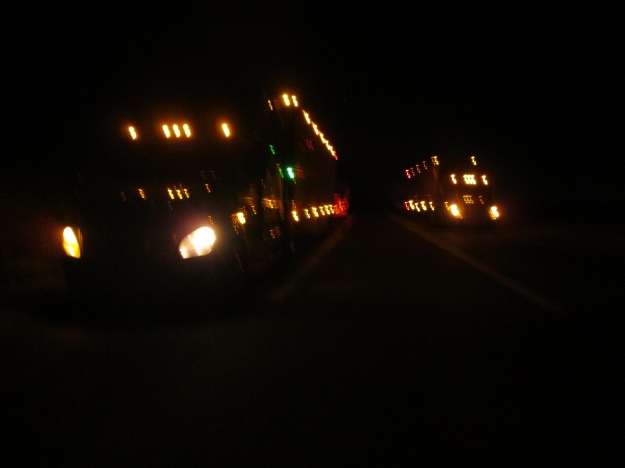August 18th, 2014
There are very few people in Wyoming.
I suppose I had always known this; however, the full force of it had never struck me before quite so insistently as it did this time. Perhaps it was more jarring than usual because of the crowded feel of Salt Lake City, or perhaps because, for once, I was not coming from South Dakota or Montana or Iowa, all of which are also comparatively unpopulated states.
I entered Wyoming via a back road, Route 6, which wiggles its way through the mountains in the southwest corner of the state, through miles and miles of empty wilderness.
Except, of course, it isn’t wilderness. True, there are few people there, but you can tell from the fencing that most of that open space is ranchland, open space for cattle.
This, too, is an amazing drive. Rural highways aren’t built like interstates; they don’t refrain from being terrifying. In many spots you find yourself driving along the edge of what seems to be a sheer cliff, the view of which makes you feel as if you’re on top of the world. It’s a wonderful way of seeing the land.
But the interstate, too, has its charms. There aren’t too many places in the nation where you can shut down one lane of a two-lane interstate for construction and not create so much as a blip in the traffic.
There also aren’t too many places left where it’s forty miles to the next town, and where it only takes you half an hour to get there, because the speed limit is eighty mph.
The city of Cheyenne, the capital of Wyoming, has a population of roughly 65,000 people. As you drive into town, you see a sign boasting that Cheyenne contains 2300 hotel rooms. To put this in perspective, the Circus Circus in Reno has 1600 hotel rooms. One hotel in one not-so-large city in Nevada, which, is, itself, not one of the most populous states.
Sixty-five thousand people. That is fewer than the number of people who live in my suburb of a suburb of a suburb of a suburb in the Bay Area. It’s incredible, and wonderful.
Sometimes I think I’d like to live in a place like this, were it not for the winter weather. I don’t even mind the snow very much, as long as I don’t have to drive. It seems to me as if you wouldn’t want to drive here in the winter, if you could avoid it. At numerous places along Interstate 80, you see signs like this:
Can you imagine what the response would be, if I-80 in the Bay Area (which is the same road, by the way) was shut down due to weather? Traffic would be backed up for weeks.
It seems a fair trade. Our traffic is backed up daily, if not hourly. Perhaps having your highway closed several times a year is a small price to pay for no rush hour, or, in our case, rush morning, rush evening, and rush afternoon.
Yes, it’s a different experience, being out here where there are probably more cows than people. I was so exhausted that I crashed in a parking area – not a full rest area, but a parking area with no facilities, the kind that truckers use. I suspect that my truck looked rather small, given the company.
States like Wyoming provide more of these types of amenities, probably because their towns are so few and far between. And in a place like this, away from even the small cities, on a highway unilluminated by any lights but those of the headlights of the occasional trucks passing by, it is so dark, and the sky is so clear and free from smog, that you can see the Milky Way. Do you know how many years it’s been since I’ve seen the Milky Way?
Urban lights are beautiful, too, in their way. There’s nothing quite like gazing down from a hilltop over a vast field of multi-colored city lights, white and yellow and green and red and orange, as if the city itself is some sprawling, highly decorated Christmas tree. Or making a turn on a dark rural highway and spotting the lights of a city in the distance, lights that offer promise, security, human companionship. Those lights beautify the landscape in a different way, in a way that speaks to our most human of instincts, the desire to be with others of our own kind. The lights are a sign, a symbol, an indication that there are more of us waiting just around the bend – they are not merely lights, but welcoming beacons.
Yet in a state like Wyoming, they seem but pale reflections when matched against the glowing, glorious, gigantic field of stars.
* * *
If you would like to see more photos from my cross-country travels, please follow my new Pinterest account at http://www.pinterest.com/lorilschafer/.
For updates on my forthcoming memoir The Long Road Home, which I am drafting during this road trip, please follow my blog or subscribe to my newsletter.







We summer in Wyoming and winter in Phoenix. Well, at least my son and I do. My husband working in Casper, WY. He can keep those miserable, snowy winters. I gave those up when I left Alaska. :D I do enjoy the solitude of the place. It’s a lot busier than it was even 5 years ago. Then, you could get out on the roads and not see anyone all day. There are days that I really miss that.
Beautiful pictures! I can’t wait to get back up there…only a month to go. :D
LikeLiked by 1 person
Sounds lovely! I’d love to live in a place like that part of the time – you can actually hear yourself think :)
LikeLiked by 1 person
It’s relaxing for sure. But full time, it gets a tad bit boring. :D
LikeLiked by 1 person
You’ve made a great case for the charms of rural Wyoming and the urban overpopulated Bay area. It’s wonderful to feel as though you’re the first traveler to ever experience a road–though you know that’s not possible, yet feel that way anyway–because you see no one else for miles. What a grand road trip you had, Lori!
LikeLiked by 1 person
I know that rural areas are generally rural for a reason, and I’m sure it isn’t quite so pleasant once winter hits. But boy, it sure was a shock coming back to “civilization.” Not a day has gone by that I don’t wish I was waking up in Montana or some such place. On the plus side, I still have many, many posts to write about the rest of my trip, which I had to stop in order to finish other projects. But I figure that will be a nice way of revisiting those other places this coming winter – without having to endure the freezing cold and piles of snow ;)
LikeLiked by 1 person
That is the clear advantage you have in the Bay area–no snow shoveling! I enjoy a similar one here in Austin. And yes, I still wake up longing to be back in the Tetons after a mere week there this summer.
LikeLiked by 1 person
The entire panhandle of Idaho only comprises 20% of the state’s population. I live on the border of the two uppermost counties and combined the counties are home to 50,000 people. Your beautiful writing about the connectivity to lights really hits home. I live along HWY 95 and am grateful for the traffic and night lights of cars in this remote region. Welcoming beacons, indeed!
LikeLike
Are you up near Lewiston? I only ask because I remember being up there and being sort of stunned at how even in a city that size, it still felt remote, and rather dark, even in town. So unlike Boise and Twin Falls, the more “mainstream” parts of Idaho.
LikeLike
I’m even further north about another 200 miles. Going to Boise is a pioneering venture!
LikeLiked by 1 person
I love the photos. It’s just like driving through parts of Australia. :)
LikeLiked by 1 person
Now there’s a place I’d love to visit! :)
LikeLike
Come on over. There’s lot to see! :)
LikeLike
You make me want to go there!
LikeLike
Great, then I’ve done my job! *emits evil cackle* ;)
LikeLike
beautiful writing, especially at the end. And yes, that’s a wow of a statistic concerning Cheyenne’s population. My Northern Cali town is exactly that size, and it is all but invisible on most California maps!
LikeLiked by 1 person
You’re not kidding! Really puts size in perspective, doesn’t it? :)
LikeLike